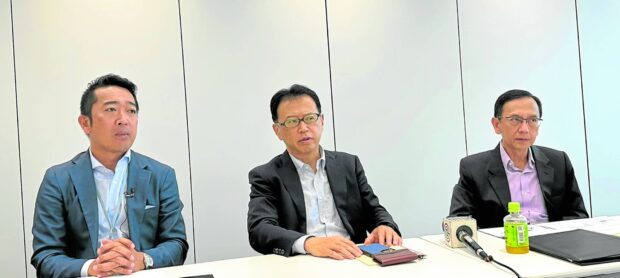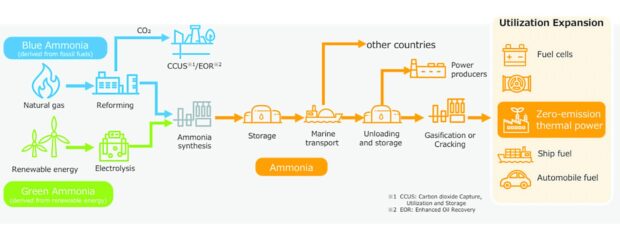Building a ‘new energy’ economy: Is ammonia key to low-carbon PH?

POWER PANEL (From left) Shinsuke Nakayama, executive officer and head of Asia platform business group; Satoshi Yajima, Jera senior managing executive officer and Aboitiz Power director; Aboitiz Power thermal group chief operating officer Felino Bernardo briefing the media in Tokyo. — Doris Dumlao-Abadilla
TOKYO, JAPAN—Ammonia, a colorless pungent gas compounded from nitrogen and hydrogen, has long been used mostly as fertilizer all over the world. Some people also know it as a first aid tool to prevent fainting.
But it could be a more important commodity in the future. Jera Co., Japan’s largest power generation company that came in as a strategic investor in Aboitiz Power in 2021, envisions that ammonia, as well as its parent hydrogen, could ultimately replace coal as fuel as the world transitions to a low-carbon future.
In February, Jera inked a deal to study ammonia co-firing at coal plants run by Aboitiz Power. This is alongside Jera’s efforts elsewhere in the world to develop the supply chain — from its sourcing to the development of suitable carriers and receiving stations.
“As a short-term goal, we think LNG (liquefied natural gas) will play a really important role in the Philippines as transition fuel. [The] Japanese government is also trying to push support for the introduction of new energy in the Philippines as a transition,” says Satoshi Yajima, senior managing executive officer at Jera, tells visiting journalists from the Philippines at the company’s office in Tokyo.
Japan pioneered the use of LNG as a cleaner, albeit still fossil-based, alternative to coal fuel more than five decades ago and Jera now operates some of the world’s largest LNG facilities.
“As you know, LNG gas-fired power plant emits half of CO2 (carbon dioxide) in comparison with coal-fired power plant, so that will add an important transition fuel from coal to LNG. Coal will continue to play an important role, but by mixing LNG in the power generation portfolio, I think the Philippines will be able to go to decarbonization step by step,” adds Yajima, who represents Jera on the board of Aboitiz Power.
For the long haul, Jera expects that ammonia and hydrogen could displace coal, especially in countries where there are no new coal-fired plants being built. The idea is to introduce these as fuel alongside coal little by little, initially firing 20 percent of total capacity (which means 80 percent is still coal-fueled) and increasing progressively until 100 percent replacement is achieved.
“Once demand comes up because of the economies of scale and [once] the value chain [has been] established, we expect price decrease. Then the Philippines will be able to introduce ammonia and hydrogen,” Yajima says.
Jera itself aims to achieve “net zero” greenhouse gas emissions in Japan through a mix of low-efficiency coal elimination, ammonia and hydrogen co-firing and renewable energy (RE).
A highly combustible gas, hydrogen alone can directly fire power plants along with coal, but it’s more difficult to transport to archipelagic countries like the Philippines, which is why the deal with Aboitiz Power prioritizes ammonia co-firing.
Experts say liquefied hydrogen is the safest and greenest to transport but liquefaction process is costly and energy-intensive. On the other hand, ammonia is a carrier and supplier of hydrogen and is able to deliver energy at three times the density of hydrogen. It is also easier to store and transport.
In landlocked areas like in the United States where there are established pipelines, Jera is pursuing hydrogen co-firing.
RE isn’t enough
The Philippines is unlikely to phase out its coal plants anytime soon as RE isn’t enough to ensure grid supply stability.
“Because of the intermittent nature of renewables, you still need to have capacity to bridge the gap when the sun is not there, when the wind is not blowing … In a way it’s still expensive. And of course, you have to have the transmission,” says Felino Bernardo, chief operating officer for thermal group at Aboitiz Power.
Japan itself is aggressively pursuing RE to decarbonize power, but it has included hydrogen and ammonia co-firing in its energy mix policy.
To date, 72 percent of Japan’s energy comes from fossil fuels (of which 50 percent is LNG) while 18 percent comes from RE and 6 percent from nuclear power. By 2050, the target is to increase RE share to at least 50 percent while hydrogen and ammonia will account for at least 10 percent.
Jera has started to co-fire ammonia at its Hekinan coal-fired power station in central Japan.
“Technology-wise, ammonia production is already established and actually, ammonia has been already used for agricultural purpose. So there’s sort of market already,” says Shinsuke Nakayama, executive officer and head of Asia platform business group.
“But if we are trying to use ammonia for power generation, that’s another huge demand. We need to be very careful not to disturb the existing ammonia market for agriculture, which has already [an] important function in the society. So that’s why we are trying to create new supply chain of ammonia power generation,” he says.
Japan alone consumes about a million tons of ammonia for agricultural purposes annually. With Jera trying to introduce 20-percent ammonia co-firing at just one of its coal plants, that will already consume about half a million tons.
“We plan to introduce this technology to all the coal-fired power plants and if the firing rate becomes 100 percent, then the size is gigantic,” Nakayama says.
Ammonia generation demonstration test is starting in Japan this year while 50-percent co-firing is scheduled by 2028 at Jera’s Hekinan and other power plants, after which commercial operation is seen to take off.

SUPPLY CHAIN In order to scale up global trading of ammonia, it is necessary to expand demand for purposes beyond agriculture and power generation, such as for fuel cells and transportation fuel – from the Decarbonization Initiatives presentation of Jera Co. Inc.
Cost considerations
In the last two decades, spot prices of ammonia averaged around $300 per ton—about twice as expensive as coal. Geopolitical uncertainties arising from Russia’s invasion of Ukraine have made it more volatile.
“And these are not green or blue ammonia. They are not decarbonized. We need to procure green or blue ammonia, which will add up the cost,” says Nakayama.
Ammonia can be “gray,” “blue” or “green” depending on the feedstock and production process. Blue ammonia is decarbonized by 90 percent via CO2 capture, utilization and storage while green ammonia is CO2-free as it uses green hydrogen produced by water electrolysis, powered by renewable energy.
In its 2023 flagship report, Paris-based intergovernmental organization International Energy Agency (IEA) says production costs of hydrogen from renewable electricity could be much lower in China and the United States ($3 to $4 per kilogram) than in Japan and Western Europe ($5 to 7/kg) using the best resources in those countries today, translating into similar differences in production costs for derivative commodities, such as ammonia.
“As countries make progress toward their climate pledges, with renewable electricity costs continuing their decline and electrolyzer costs falling rapidly, the cost difference between regions is likely to shrink somewhat, but competitiveness gaps will remain. Carefully considering where in the supply chain to specialize domestically, and where it might be better to establish strategic partnerships or make direct investments in third countries, should form key considerations of countries’ industrial strategies,” IEA says.
IEA adds that new infrastructure will form the backbone of the new energy economy in all countries, covering areas such as the transportation, transmission, distribution or storage of electricity, hydrogen and CO2.
“Building clean energy infrastructure can take 10 years or more, typically involving large civil engineering projects that have to adhere to extensive local planning and environmental regulations,” it says.
While construction is in most cases a relatively efficient process, taking just two to four years on average, IEA notes that planning and permitting can cause delays and create bottlenecks, with the process taking two to as long as seven years, depending on the jurisdiction and type of infrastructure. Lead times for infrastructure projects are seen to be much longer than for the power plants and industrial facilities that connect to them.
Opening the door
The Philippines is highly receptive to new energy technology. Energy Secretary Raphael Lotilla says the government is “actively considering” ammonia and hydrogen as part of the energy mix.
Nearly 60 percent of the Philippines’ electricity is fueled by coal, but if the same coal-fired power plants could be refurbished to increasingly burn ammonia, assuming the global supply chain has been well established, this is seen to boost the country’s march toward a net zero future.
But to scale up global trading of ammonia, Jera recognizes that it’s necessary to build a new supply chain to create new demand beyond agriculture and power generation, such as for fuel cells, shipping and automobile fuel.
“I don’t know by when and how much, but there will be a clear trend of price reduction,” Yajima says with confidence.
